Earlier this month, the U.S. Marine Corps officially activated its first unit that will carry Tomahawk cruise missiles. Before the end of the decade, the service expects that this unit will be operational. As one of America’s top-tier tools of hard power, the Tomahawk precision-guided cruise missile would be a significant asset if kinetic war does break out in the South China Sea.
The Marine Corps Navy Marine Expeditionary Ship Interdiction System (NMESIS) currently uses Naval Strike Missiles, which have a range of 115 miles. Since the Tomahawk is capable of reaching targets up to 1,000 miles, Maritime Strike Tomahawks would give the service a long-range strike capability.
A spokesperson for Marine Corps Combat Development and Integration told Task and Purpose that MST “broadens the Tomahawk target set to include moving targets such as ships, in which case a geographic combatant commander could employ ground-launched MSTs as part of a Naval sea control or sea denial campaign.” Essentially, these missiles could be used to target Chinese vessels if a war in the Pacific erupts.
A brief history of the Tomahawk
The Tomahawk Land Attack Missile (TLAM) was first manufactured in the 1970s by General Dynamics to fulfill the military’s need for a low-altitude missile that could be operated from a naval surface warfare platform. Since its introduction to service, several “blocks” or progressive variants of the Tomahawk have emerged, each subsequent series hosting new improvements. In the early 1990s, McDonnell Douglass Corporation was the only Tomahawk supplier, producing Block II, Block III, and remanufactured Block III variants. Ultimately, Raytheon became the sole producer of non-nuclear, sea-based Tomahawk variants. Block II and III variants were modified to target both hardened and soft targets with greater precision. Electronic upgrades in addition to a new turbofan engine made these editions more formidable than their predecessors.
The current Block IV variant, called the Tactical Tomahawk (TACTOM), features a data link that enables it to switch targets mid-flight. Similar to a loitering munition, this version can linger around a target area for an extended period of time and have its trajectory altered in an instant. In 2016, the U.S. Navy requested more than $400 million to upgrade 24 TLAMS for anti-ship missions. Basically, these enhanced Tomahawks can destroy enemy ships up to 1,000 nautical miles away. Currently, the Block IV model is the only Tomahawk edition of the previous four still manufactured.
The Tomahawk has been combat-tested
The Tomahawk’s initial deployment during the 1991 Gulf War achieved success. During Operation Desert Storm, these missiles were launched from the USS Paul F. Foster (DD-964) and aimed at Iraqi targets. Able to take out scores of military infrastructure ahead of time, the Tomahawk proved to be an asset in combat. However, in the subsequent 2003 Operation Iraqi Freedom, the Tomahawk’s TERCOM system struggled to guide the missiles directly toward targets.
As the Center for Strategic and International Studies detailed, roughly ten Tomahawks missed their targets in the initial stage of Iraqi Freedom, crashing into the ground in Iran, Turkey, and Saudi Arabia.
More recently, the U.S. fired 59 Tomahawks in 2018 toward the Shayrat Air Base to target Syrian assets following a chemical weapons attack carried out by Syrian President Bashar al-Assad.
Maya Carlin, a Senior Editor for 19FortyFive, is an analyst with the Center for Security Policy and a former Anna Sobol Levy Fellow at IDC Herzliya in Israel. She has by-lines in many publications, including The National Interest, Jerusalem Post, and Times of Israel. You can follow her on Twitter: @MayaCarlin.
From 19FortyFive
A Russian Submarine Accidently ‘Destroyed Itself’
Total Massacre’: Ukraine Footage Shows Russian Cruise Missile Shipment Attacked

